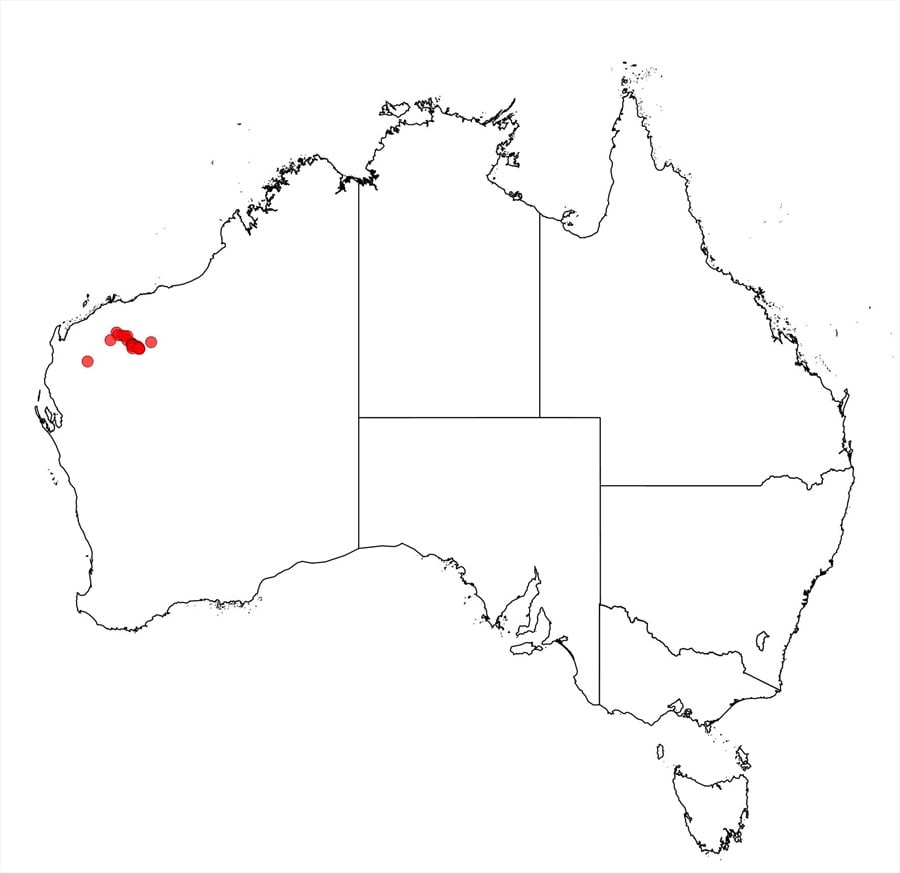Acacia exigua I.M.Turner
WATTLE
Acacias of Australia
Common Name
Muntalkura Wattle
Family
Fabaceae
Distribution
Confined to a restricted area of the Hamersley Ra. mainly in the general vicinity of Tom Price (extending from Hamersley Stn SE to Coppin Pool); also grows near Mt Windell, about 50 km NE of Coppin Pool, W.A.
Description
Shrub or tree (1–) 2–6 m high; crown normally dense. Bark fibrous, grey. Branchlets terete, obscurely (non-resin) ribbed, glabrous. Phyllodes filiform, slightly curved to shallowly sigmoid, terete, (10–) 14–18 cm long, c. 1 mm diam., with normally delicately curved to uncinate tip, not rigid, pale subglaucous, glabrous except pulvinus being adaxially puberulous at base, finely striate. Inflorescences simple, 2 per axil; peduncles 8–13 mm long, glabrous; spikes 10–20 mm long, subdensely flowered, light golden. Flowers 5-merous; sepals united into a sinuate-toothed cup, 1/4–1/3 length of petals, villous. Pods linear, flat but slightly raised over seeds and constricted between them, sub-straight to moderately curved (into an open semi-circle), to 9 cm long, 4–5 mm wide, firmly chartaceous, greyish brown, glabrous. Seeds longitudinal, oblong-elliptic to elliptic, 4–5 mm long, slightly shiny, brown; areole minute; aril terminal, whitish.
Habitat
Grows on low rocky hills in iron-rich soils derived from Marra Mamba and Brockman Iron Formations, with several Acacia spp. and a ground cover of spinifex.
Specimens
W.A.: Tom Price, 0.8 km from minesite entrance, K.Atkins 1221 (CANB, K, PERTH); Hamersley Ra., E.M.Cole WA5097 (PERTH); 27 km from Tom Price on road to Paraburdoo, B.R.Maslin 4666 (BRI, CANB, K, MEL, NY, PERTH); Hamersley Ra. Natl Park, 1.4 km SW of hut at Coppin Pool, M.E.Trudgen 2548 (AD, BRI, NSW, PERTH).
Notes
The name A. exilis Saporta was described for a fossil-species from France, fide I.M.Turner (l.c). Most closely allied to A. tenuissima which has resin-ribbed branchlet apices, generally shorter phyllodes, shorter, pale yellow, more densely flowered spikes, narrower pods and yellow arils; moreover, A. tenuissima is commonly a shrub to about 2 m high. Sometimes sympatric with A. aptananeura which is distinguished by its grey-green phyllodes, more densely flowered spikes, free sepals and broader pods.
Resprouts from the base following fire. Phyllodes contain relatively high concentrations of cyanogenic glycoside but it is not known if they also possess an endogenous enzyme necessary for converting glycoside into toxic hydrogen cyanide; the species is not known to be incriminated in stock losses.
FOA Reference
Data derived from Flora of Australia Volumes 11A (2001), 11B (2001) and 12 (1998), products of ABRS, ©Commonwealth of Australia
Author
Edited by B.R.Maslin
B.R.Maslin, R.S.Cowan
This identification key and fact sheets are available as a mobile application:
URL: https://apps.lucidcentral.org/wattle/
© Copyright 2018. All rights reserved.
 Acacia exigua occurrence map
Acacia exigua occurrence map




